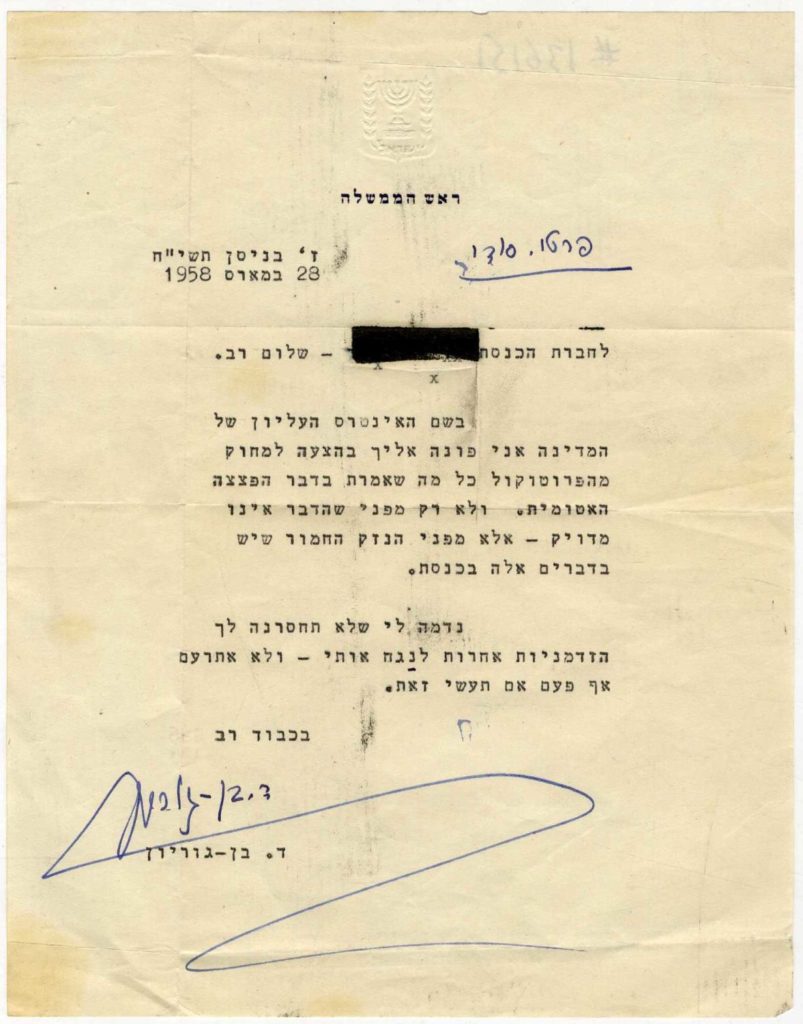
Fascinating private-secret letter in which the then Prime Minister Ben-Gurion asks member of Knesset Esther Raziel Na’or to erase from the protocol “Everything you said about the atomic bomb,” this due to the “severe damage such words in the Knesset might cause.”
The efforts of the state of Israel to obtain nuclear bombs began already during the 1950s, after the leaders of Israel concluded that Israel must not rely only on a conventional army and due to the numeric advantage of the Arab states, Israel must develop nuclear weapons that will serve as a tiebreaker.
Israel has never admitted that it has nuclear weapons and its official policy is “Israel will not be the first country to introduce nuclear weapons to the Middle East, yet it will also not be the second one to do so”.
This document reveals the Israeli government’s efforts to conceal its nuclear policy.
The name of the addressee was covered by black ink; however the words “Raziel-Naor” are clearly distinguished. Esther Raziel-Naor was member of Knesset of the ‘Cherut’ party from the first Knesset to the seventh. She was the sister of the commander of the Irgun, David Raziel.
In an examination of the protocols of the Knesset plenum, the Knesset committee and the education committee (of which Raziel-Naor was a member in those days) words by her regarding nuclear weapons were not found; which shows that she most likely accepted the Prime Minister’s request to erase her words from the protocol.
The content of the Hebrew letter :
To member of the Knesset XXXXX XXXX (Raziel Naor) Shalom,
On behalf of the uppermost interests of the State, I appeal to you with a recommendation that you erase from the protocol everything you said regarding the atomic bomb. And not only because the words are imprecise – but because of the severe damage such words in the Knesset might cause.
I think that there will be other opportunities for you to taunt me – and I will not resent it if you do so.
Respectfully,
Ben-Gurion
[1] leaf, official Prime Minister’s stationery with a monogram of the emblem of the State of Israel on the upper part. 16×21 cm. Typewritten with Ben-Gurion’s handwritten signature in blue ink. On the upper part of the letter, Ben-Gurion added in his handwriting the Hebrew words “Private, secret.”
Very fine condition. Fold marks and aging stains. A few ink stains which smeared when the name of the addressee was concealed.
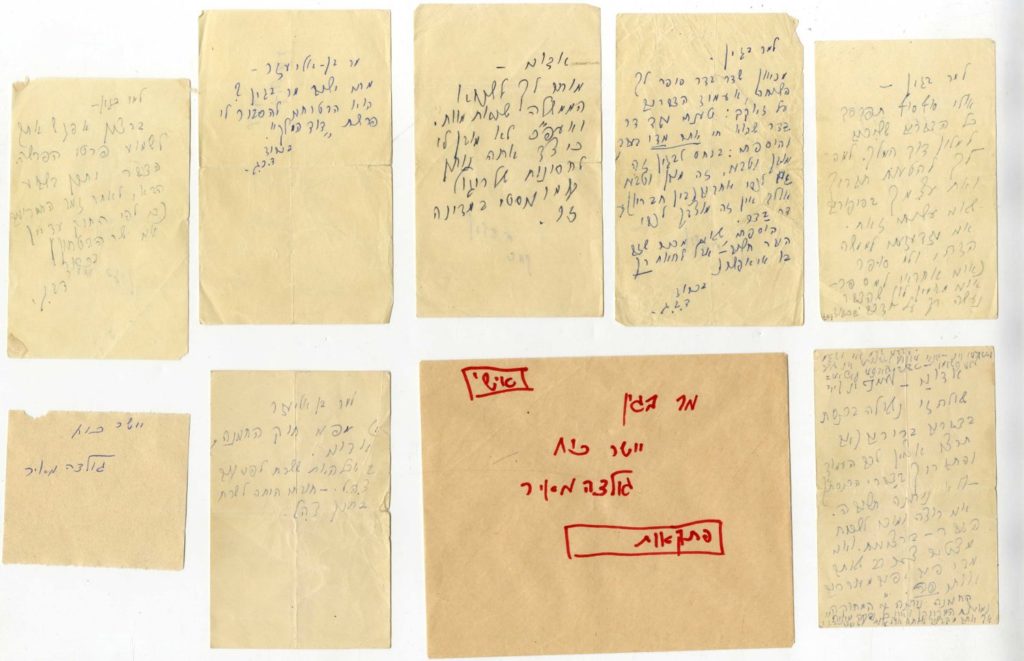
Seven notes Ben-Gurion sent to his bitter rivals from the Cherut party, with Begin at their head. On the occasion of the establishment of the united party in 1967, the Poalei Yisrael party entered the government. Ben-Gurion decided that he was not interested in joining the government, and he decided to establish a party of one. Ben-Gurion was especially bitter towards his former colleagues in the party. Among the notes:
* Note in which Ben-Gurion tells Begin that “One is allowed to hate the government with death-hatred,yet despite this I don’t understand how you give immunity to Communist espionage in this country.”
* Note from Ben-Gurion to Begin about the King David Hotel Affair (referring to the Jewish Resistance Movement blowing up the British headquarters in Jerusalem in 1946).
* Note from Ben-Gurion to Begin in which he tells him that he would be happy to meet with him after he is no longer legally defense minister.
* Note from Ben-Gurion to Begin about the importance of non-immersion in the past, an interesting and relevant note because of the central topics with which the Cherut movement dealt in the first years of the state, emphasizing the activities of the Irgun fighters and the struggle for the establishment of the state.
* Note from Ben-Gurion to MK Aryeh Ben-Eliezer.
* Note from Ben-Gurion to MK Aryeh Ben-Eliezer: “When will Mr. Begin come back? He promised to explain the ‘King David’ affair to me. Respectfully, D.B.G..”
The notes are placed in an envelope with “Mr. Begin, well done! Golda Meir” is written. She also added a note on which she wrote “יישר כוח.”
[8] notes with an average size of approximately 8×13 cm, placed in an envelope 12×15 cm.
Overall fine-very fine condition, fold marks and and tiny tears. All the text is legible.
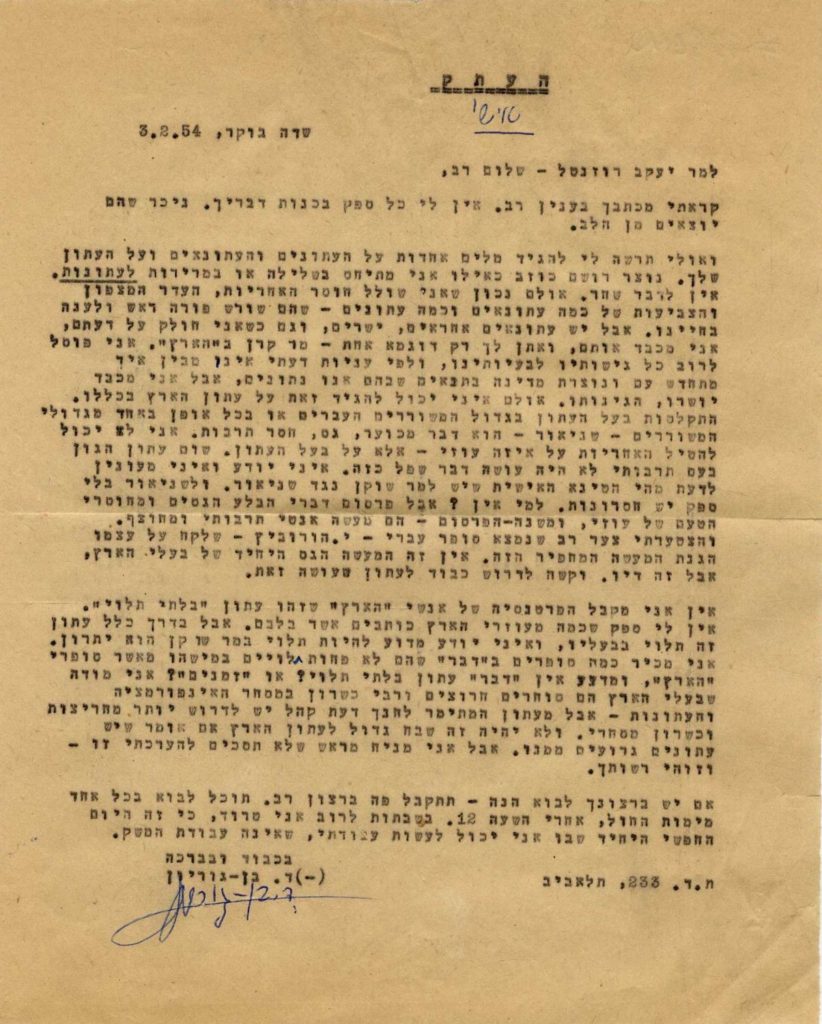
Fascinating historical document from Ben-Gurion to Yaakov Rosenthal regarding the press, the media and the newspaper Haaretz .
Letter with curious expressions. Ben-Gurion claims that there is no such thing as “independent” media and that every outlet represents the interests of its owners. He says that he does not have a negative attitude towards the press, but there are a few papers that are a source of trouble. Towards the end of his letter, he notes that he is open to a visit any day of the week after 12:00 p.m., but on Shabbat he is very busy, since it is the only day that he does not need to work on the kibbutz farm.
[1] leaf. 20×25 cm. Copy typewritten with the penned signature of Ben-Gurion at the bottom of the letter. Ben-Gurion added the word “personal” at the top of the letter. Very fine condition, fold marks, 2 tiny marginal tears.
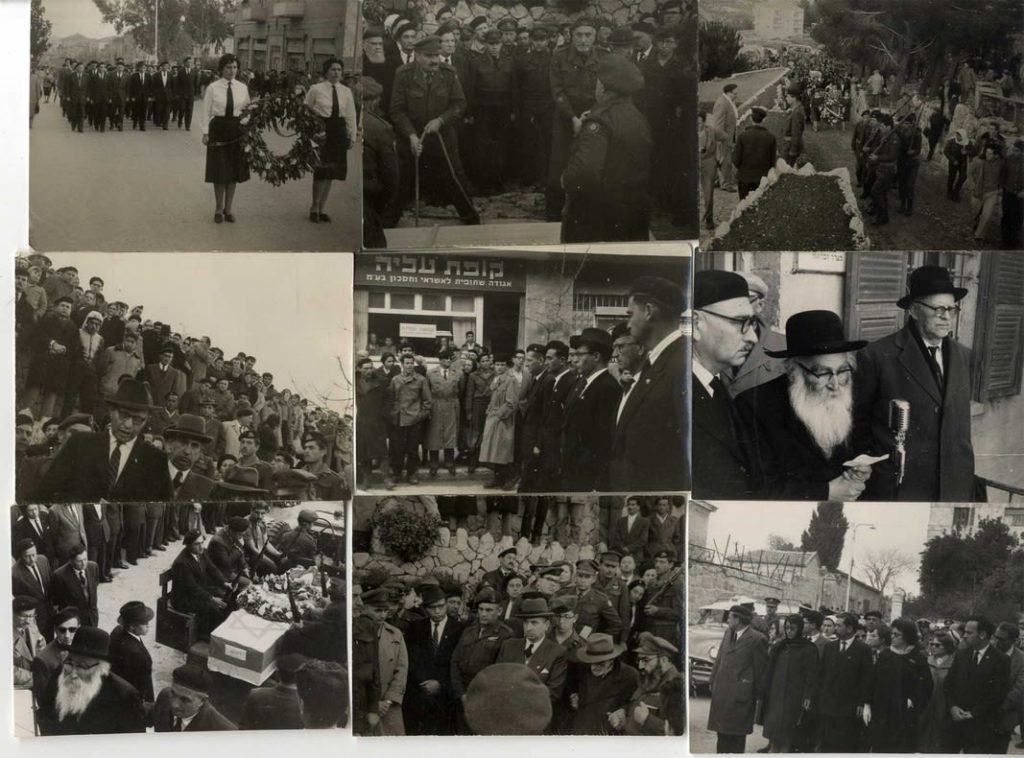
25 Photographs from David Raziel’s funeral. Among those photographed – Rabbi Aryeh Levin, Rabbi Shlomo Goren, Menachem Begin and more. The photographs show the honor guard and rows of the leaders of the Irgun paying their final respects to their commander.
David Raziel (1910-1941) was the commander of the Irgun. In his youth, he studied at the Merkaz HaRav yeshivah, where his study partners were Rabbi Tzvi Yehudah HaKohen Kook and Rabbi Avraham Shapira, who eventually served as heads of the yeshivah. Raziel was one of the founders of the Irgun, after it was decided to break away from the Haganah. After he had met with Raziel, Jabotinsky noted that he had been waiting for a person like Raziel for 15 years and had decided to appoint him governor of Beitar in the Land of Israel. After the outbreak of World War II, the Irgun decided to join the British in their war against the Nazis (which was what led the Lech”i to part from it). Raziel was appointed by the British to head a small commando unit that was sent to Iraq, where he was killed during on attack on Fallujah.
Raziel was buried in Iraq by the British and many efforts were made to bring his body to Israel. Only in 1955 did the Iraqis agree to release his remains provided that he would be reburied in Cyprus and not in Israel. In 1961, Menachem Begin succeeded in convincing the new leader of Cyprus to release his remains and on the 28th of Adar, Raziel’s funeral took place on Mount Herzl in Jerusalem with the attendance of thousands.
[25] photographs. 7×9 cm. Very fine condition.
In addition, a handwritten letter by Rabbi Aryeh Levin to David Raziel’s family from the sixth of Nissan 1962 is included. In the letter, Rabbi Aryeh encourages the family to rejoice during the Passover festival and brings a widow named Rachel Leah as an example. This very widow’s grandson, Shneur Zalman Cheshin, eventually became a judge in the Supreme Court. Rabbi Aryeh tells the Raziel family that the aforementioned widow always tried to happily celebrate Passover and he implores the Raziel family to emulate her. [1] paper leaf. 21×11 cm. Very fine condition. Fold marks.
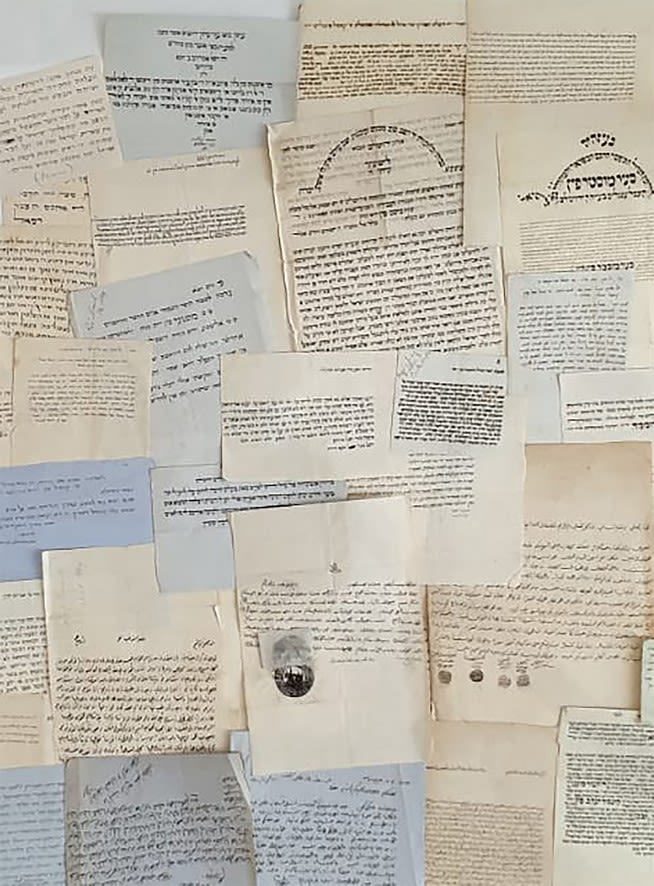
Fascinating archive of dozens of letters by rabbis and personages of the Old Yishuv, of the Ashkenazic and Sephardic communities alike, which reveal for the first time a warm and appreciative relationship between them and the English consul. Late 19th Century.
Dozens of consuls of the various powers were positioned in Jerusalem towards the end of the Ottoman rule, ever since the establishment of the British Consulate in 1838. However, none of them earned a reputation like James Finn (1806-1872), who served as the British consul for 17 years (1846-1863). He left his impression on the history of the Land and the Jewish settlement and there was no other consul in Jerusalem who received such extensive publicity in his lifetime and about whom so much was written, especially what he did for the Jewish settlement.
Even before he received the position, he was interested in the Jews and their history and contacted the heads of the British Mission, which was then just beginning, and even took part in its activities. However, at the eve of his departure to Jerusalem, he severed his relations with them.
His interest in Judaism led him to methodologically study the Hebrew language and he could read the bible and other holy scriptures. He was even able to conduct a simple conversation in Hebrew and read a letter that was written in simple Hebrew. These facts removed the barriers between him and various apostates as well as Jews who appealed to him in times of need, thus increasing their trust in him. Moreover, his amity towards the Jews was reflected in his devoted efforts to help the Yishuv in times of distress with remarkable devotion, by creating employment opportunities, helping the poor, defending the Jews against evildoers and more. His most well-known enterprise was the establishment of the ‘Kerem Avraham’ neighborhood (1852), which was meant to provide means of sustenance to poor Jews, an idea that was brought up during the Crimean War crisis. This philanthropic enterprise saved hundreds of families and provided many with a profession and skills in the fields of construction and agriculture.
His missionary activity is controversial. The fact that he acted for the benefit of apostates caused various scholars to determine decisively that he indeed engaged in missionary activity. During his lifetime he was already accused of this by Jews and non-Jews alike. On the other hand, there are scholars who claim that he never tried to convince anyone to convert nor was he involved in any other activity related to conversion. While it is true that he took care of converts and tried to supply their needs, and joyously participated in conversion ceremonies, he did all this without being a missionary himself.
On the other hand, already during his first years as consul, Finn worked diligently to tighten his connections with the leaders of the Jewish settlement. He visited many synagogues, took part in celebrations of the Jewish residents of Jerusalem and established friendly relations with them. The consul had two translators, one Ashkenazic, an apostate who had repented, named Shimon Rosenthal, and the second a Sephardi named Raphael Avraham Meyuchas.
Discoveries:
The collection contains rich material for studying the consul in particular and the old Yishuv in general. The scholar, Prof. Mordechai Eliav, who studied the British consul, considering the two positions, the one that suspected he was a missionary and the other that cleansed him of any sin, determined that despite his vigorous activity for the Jews and “despite his good deeds,” concerns about his missionary activities overpower the goodness of his deeds. This collection, which contains many letters of gratitude, from all kinds of people of the Jewish settlement, and which are phrased in a most warmhearted style, proves otherwise.
* Letter of appreciation for the help given in the past and a request for the future by Rabbi Yaakov Slonim: “And our request and certainty that in the future he will protect us at any time …” Rabbi Yaakov Slonim, patriarch of the Slonim family, son-in-law of the middle Admor Rabbi Dov Ber Schneersohn of Lubavitch, son of Rabbi Shneur Zalman of Liadi, author of the Tanya , immigrated to Hebron according to the instruction of the ‘Tzemach Tzedek’ c. 1843 was one of the founders and leaders of the Chaba”d settlement of Hebron.
* Letter of appreciation on behalf of the Sephardic and Ashkenazic communities of Hebron, for his help in saving them from the enemy: ‘And by his strong hand they were humiliated …’
* Letter of appreciation by Rabbi Yosef Yom Tov Meyuchas, one of the activists of the city, for agreeing to accept his son Raphael Avraham as his translator.
* Letter with a request for help by Chaim Weisman for the Jews of Österreich who had yet to establish an independent Kollel. Tiberias 1857. Weisman was born in Brody in 1803. He studied medicine in Bucharest and then moved to Tunis to practice medicine. From there he immigrated to the Land of Israel in 1828 and settled in Tiberias. He lost his wife and two sons as well as all of his many possessions in the earthquake of 1837. After the earthquake, he built a hotel for travelers and visitors to Tiberias, some of whom described him in their books.
* Secret letter by the emissary of the Chaba”d Kollel Rabbi Shneur Zalman son of Rabbi Menachem Mendel to the consul. He traveled as an emissary of Chaba”d, mainly to Arab countries. In 1864, he printed the book Chemdah Gnuzah in Jerusalem, which contains responsa by the Geonim from manuscript and he certainly sold it to the communities he visited on his trips as an emissary. In 1866, he printed the book Kol Aryeh in Jerusalem, novellae on the Talmud by his grandfather Rabbi Aryeh Leib Charif, Av Beit Din of Homel. In the preface of the book, he recalls the routes of his missions, a most fascinating journey indeed. In 1876, he printed his book Zichron Yerushalayim , together with the book Em LaMassoret by his grandfather Rabbi Aryeh Leib Charif. The aim of the book was to invoke love for the Land of Israel. In it, he described in detail the yishuv and the cities he had gone through on his way. He is the one who succeeded in soliciting donations from the Sassoon family of India for building Chaba”d synagogues in Hebron and in Jerusalem.
In this letter, he updates him about secret issues related to his mission. [India], 1859.
* Interesting letter by Rabbi David Sasson of Jerusalem [not Rabbi David the son of Rabbi Suleiman Sassoon of India] in which he reveals nasty business that occurred at the consul’s house and for which he was not responsible. Rabbi David Sasson of the Jerusalem sages, signs in 1859, a ‘letter of appointment’ of Rabbi David Aryeh HaCohen, a gabbai and treasurer of the Jerusalem Fund in Trieste. [Jerusalem], Rosh Chodesh Nissan 1858.
* A letter of plea by the workers of ‘Kerem Avraham’ about the strict hand of their employers. Jerusalem 1904.
* Letters of protest against the Mission, and more. Letters by the leaders of the Yishuv and by laypeople, such as: the rabbis of the Meyuchas family, Rabbi David Tevele of Lomza, the heads of the Warsaw kollel, and more.
* A Ladino confirmation by the Sephardic community to the emissary Raphael Avraham Pinchas for the consul.
A total of 24 letters, all of them written in Hebrew and approximately eight additional letters in Ottoman language. Very fine overall condition.
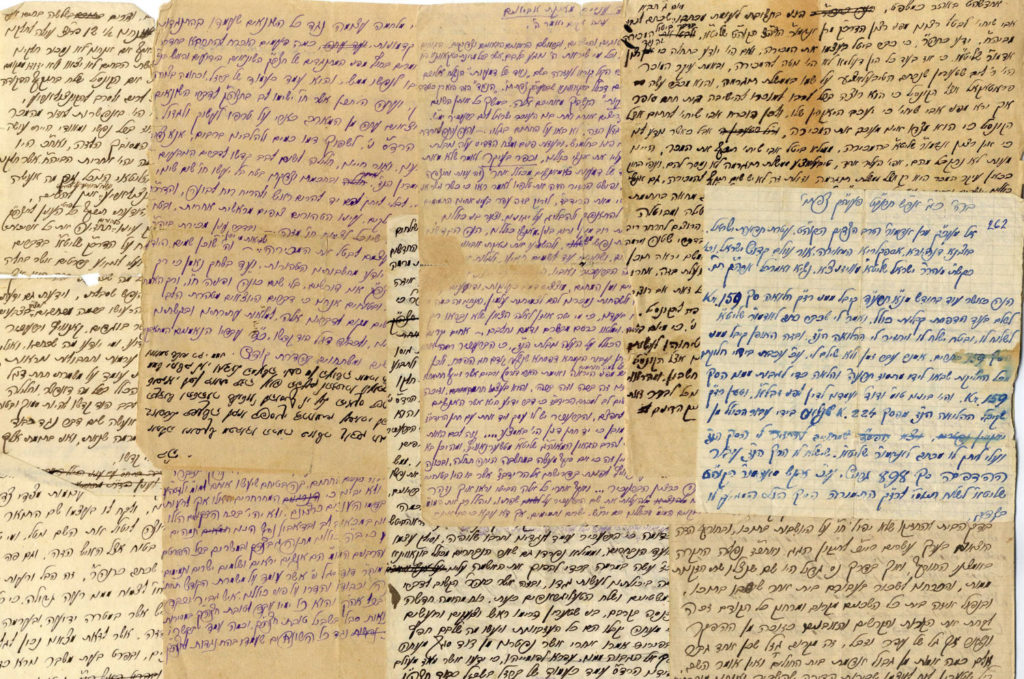
Invaluable treasury of over 100 documents, certificates, receipts, court rulings, and letters related to the Kollel Österreich in the Galilee. Some feature unknown historical revelations. [1860-1922].
When Galician immigrants in the holy cities of Jerusalem, Safed and Tiberias complained that they were being pressured by the trustees of the Russian kollel, Rabbi Chaim of Kossov, author of the Torat Chaim , opened Kollel Österreich together with Rabbi Mordechai Zeev Itinga, author of Magen Gibborim . They both served as “nasi” of the kollel. Rabbi Chaim was the nasi of the “Rabbi Meir Baal HaNes” kollel of the Jews of Bukowina, Maramureș, and part of Eastern Galicia, and Rabbi Mordechai Zeev was in charge of Western Galicia. When the author of Torat Chaim passed away in 1854, a disagreement arose between his sons regarding a successor for the Land of Israel administration. He had three sons: Rabbi Yaakov Shimshon, who took over his position in Kossov; Rabbi Yosef Alter, who ascended to the Land of Israel; and Rabbi Menachem Mendel, author of Tzemach Tzaddik , who settled in Vizhnitz. Two kollels were developed by his sons, for Kossov and for Vizhnitz, with the regions of each administered by Kollel Österreich. This led to disputes regarding who was in charge of which region – because the kollels were both funded from the same resources. In 1863, upon the passing of Rabbi Mordechai Zeev, his son – Rabbi Yitzchak Aharon, author of the Shu”t Mahari”a HaLevi , took over his position as nasi.
Vizhnitz representatives were: Reb Moshe (son-in-law of R’ Gershon) Tzeiger, his son-in-law Reb Todros – son of Rabbi Y. L. Lebech, Reb Mendel of Kopishnitz and Reb Yonah of Tarnopol. A few years later, disagreements broke out between the trustees themselves. Another wave of dispute began in 1867, when Reb Yissacher Dov Lustman of Sanok arrived in Safed and was appointed trustee of the Österreich Kollel on behalf of Lemberg. A sharp dispute broke out between Reb Dov and his supporters and the Vizhnitz trustees. To add fuel to the fire, the Austrian consul got involved. Hundreds of Austrian Jews living in Safed and Tiberias found it difficult to use the services of the Austrian consulate in Jerusalem. After many requests, the general consul in Beirut sent a consular agent to Safed in 1868, and he sided with the Vizhnitz faction.
To make things worse, in 1875-1877 an additional sharp controversy ignited between the administration of the Österreich Kollel in Safed and the “Nasi Eretz-Yisrael” in Lemberg, Rabbi Yitzchak Aharon Itinga. The dispute generated many placards supporting each side. In an “open letter” published in 1876 by the Land of Israel representatives who traveled to Lemberg – R’ Elimelech Perlman of Jerusalem and Avraham HaLevi Kalisher of Safed – they imply criticism of the management of Rabbi Yitzchak Aharon and express hope that things would improve upon his resignation. A few months later a “critical letter” was published with stinging opposition to the trustees and support for Rabbi Yitzchak Aharon. As far as is known, Rabbi Yitzchak Aharon continued serving in this role for many years after this, and the dispute came to rest without any significant administrative changes in Safed or Lemberg.
An agreement was reached between the Tzemach Tzaddik and Rabbi Yitzchak Aharon Itinga [refer to Siftei Tzadikim , 5] in 1886. In 1880, Rabbi Yaakov Shimshon of Kossov passed away, and his only son, Rabbi Moshe Hager, author of Leket Ani , took over his position, including the title “Nasi HaKollel.” This triggered another row of disputes between the offices. In 1886, both sides reached an agreement to unite the two kollels. In 1890, there were some irregularities in the Vizhnitz Kollel, and a complaint was lodged with the Imrei Baruch, who expressed his opinion and admonitions on the issue.
An external controversy continued to flare the conflagration: a dispute between the chassidim of Sighet, also from the Maramureș area, which negatively affected donations to “Maot Eretz Yisrael” [Refer to Winner’s Catalog, 100, item 41, letter from the Ahavat Yisrael in 1908]. In 1908, a big disagreement broke out in Sighet between the chassidim of Vizhnitz and Sighet. The chassidim of Vizhnitz wanted their rabbi, the author of Ahavat Yisrael , to continue serving as Nasi Kollel Maramureș in Safed, but the Sighet faction wanted their rabbi, Rabbi Chaim Tzvi Teitelbaum, author of Atzei Chaim (1881-1926), to serve in this position. After many fights over a short amount of time, the two sides agreed to bring their claims to a beit din with five adjudicators: each side chose two adjudicators, and the four adjudicators chose a fifth – the author of Arugat HaBosem of Chust. The beit din ruled that Maramureș should be divided into two sections, the Ahavat Yisrael would be nasi of one section and the Atzei Chaim would be nasi of the other. This controversy triggered a “civil war” amongst the Orthodox Jews in the country. Every day the atmosphere was colored with lampoons, each one justifying itself or incriminating the other side, friendships were broken and hatred spread, destroying integrity and blinding people’s eyes. Unfortunately it generated a wholesale profanation of G-d’s name and the honor of the Jewish nation.
This complex network of disputes and many matters regarding the distribution of land and monies, and other issues that shed light on this period, considered the golden age of spirituality-Chassidut in the Galilee, are highlighted in this rich collection. There are dozens of letters – including letters from tzaddikim – certificates, special receipts, lists, both internally within Safed and updates from elsewhere. Includes lists of donors to the different kollels, and signatures of the recipients. A rich treasury for researchers of Safed and Tiberias in particular, and scholars of the period in general.
Highlights:
* Series of letters from the heads of the kollel to the Admor with respect to the scandal in the Vizhnitz and the Kossov kollel “After bowing and prostrating in holy splendor … MHDR”K shlit”a … an enemy of the Jews, Aryeh Brecher, will certainly send letters of hate to the holy court …”
There is another document referring to him: an arbitration decision between him and the Admor Rabbi Chaim Hager of Antonia signed by Rabbi David Frankel, Av Beit Din of Nepalakwicz.
* Letters on the topic from the gaon the holy Rabbi Yitzchak of Radowitz.
* Colorful receipt in scribal script to the donors abroad who gave substantial sums, with the first signatory being Rabbi David Yehudah Auerbach, grandson of the author of Toldot Yaakov Yosef and grandfather of the gaon Rabbi Shlomo Zalman Auerbach (Afterwards, when he could no longer tolerate the poverty in Safed, he moved overseas where he served as an Admor).
* Letter from the gaon Rabbi Shalom Gutman, Av Beit Din of Iaşi, author of Beit Yisrael . Grandson of the ‘Dege”l’ Machaneh Ephraim, the Ba’al Shem Tov, Rabbi Levi Yitzchak of Berdichev and Rabbi Nachum of Chernobyl, in which he details who of the righteous men of Safed and Tiberias will receive the monies he sent.
* Handwritten notice, signed, with a sharp protest against the “saboteurs in the vineyard of the Jewish people.” Blurred rabbinical signature.
* Letter from Rabbi Naftali Hertz Itinga son of Rabbi Yitzchak Aharon Itinga, Av Beit Din of Lvov, who served as the Nasi Eretz Yisrael in Galicia.
And many other important historic documents. Refer to the Hebrew text on Winners’ website for a detailed list.
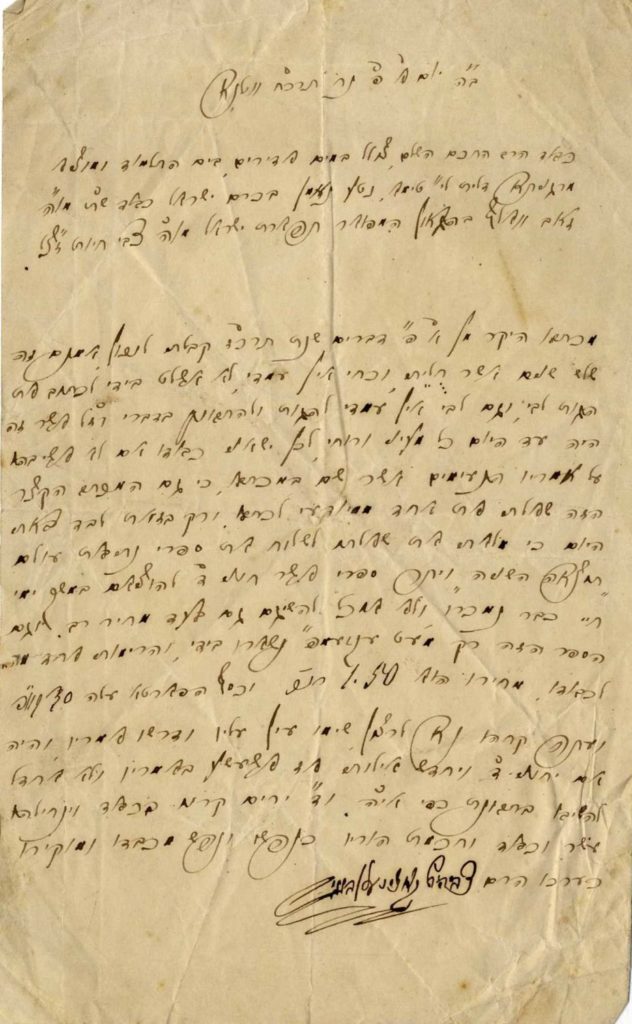
Rabbi Zev Wolf Chajes was the youngest son of Rabbi Tzvi Hirsch Chajes [1845-1901]. He was a proficient Torah scholar and dedicated researcher. He published articles on the history of the Early Authorities in various journals.
Writers include: Rabbi Shlomo Yosef Fuenn – Jewish author and researcher from Vilna (including correspondence regarding things found in the archive of Rash”i Fuenn); Rabbi Yosef Breuer of Lublin; Tzvi Hirsch Katzenelenbogen – principal of the school in Vilna; Eliezer Lipman Zilberman – editor of the journal HaMaggid and publisher of Mekitzei Nirdamim ; Rabbi Moshe Aryeh Leib Hermelin – scholar, author and editor who authored HaCholetz , which opposed the Galician maskilim.
The letters discuss recently printed books and articles and studies written about various subjects along with halachic and talmudic discussions.
Various sizes. Overall moderate-fine condition.
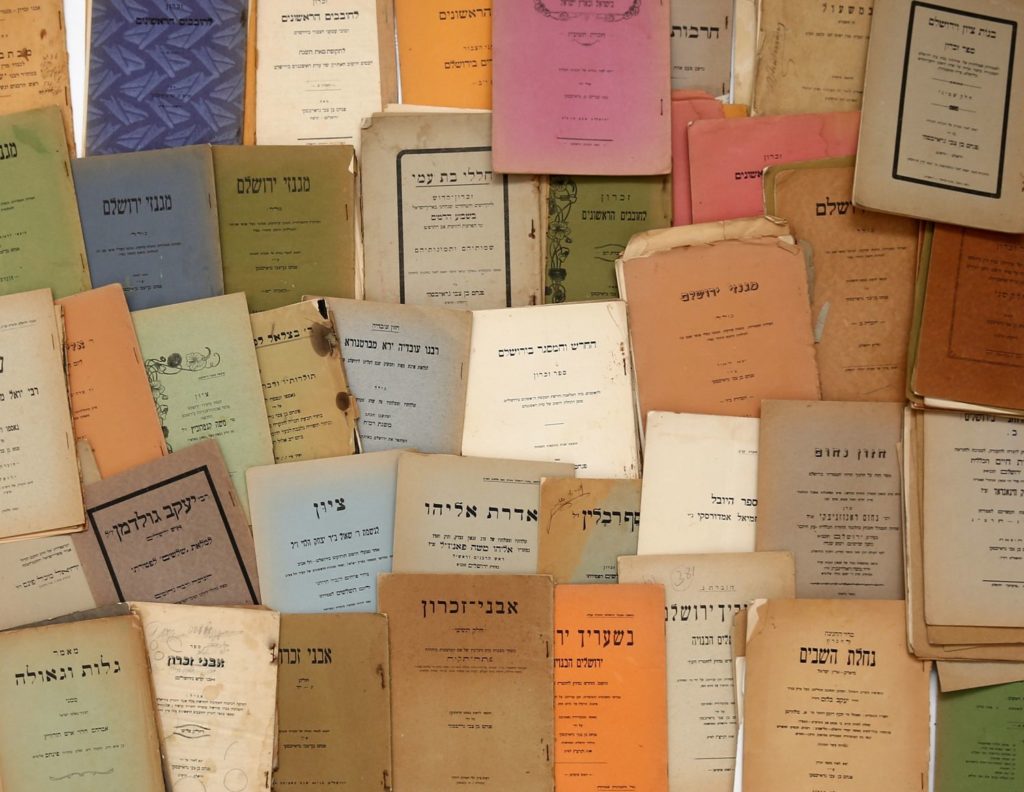
Expansive collection of [more than 80] booklets about the history of Jerusalem and the Holy Land, articles and letters by Pinchas Grayevsky and more. Jerusalem, 1920s-1940s. Treasury of a wide variety of reading material from the prolific pen of noted Jerusalem author and researcher, Pinchas son of Tzvi Grayevsky, and another 13 soft-covered booklets and books from other writers, Jerusalem, 1920s-1940s. The collection includes: Chalalei Bat Ami – elegy in memory of the victims of the pogroms of 1929, including the names of those killed and very harsh pictures. Series of [10] Zi chron L’Chovavim HaRishonim – collection of booklets memorializing noted personalities from the Old Yishuv. Series of [4] Avnei Zikaron booklets – epitaphs from various cemeteries in the Land of Israel. B’Sha’arayich Yerushalayim – two booklets regarding the history of the new settlements outside the Old City walls. [17] Zikaron booklets dedicated to private individuals. Collection of [13] MiGinzei Yerushalayim booklets, treasury of articles, stories, pictures and letters of the spiritually elevated Jerusalem. [5] booklets praising the Jewish women in the Land of Israel. Selection of [30] soft-covered booklets and books: 17 by Grayevsky and 13 from other authors, on various subjects.
Various sizes. Overall moderate-fine condition.
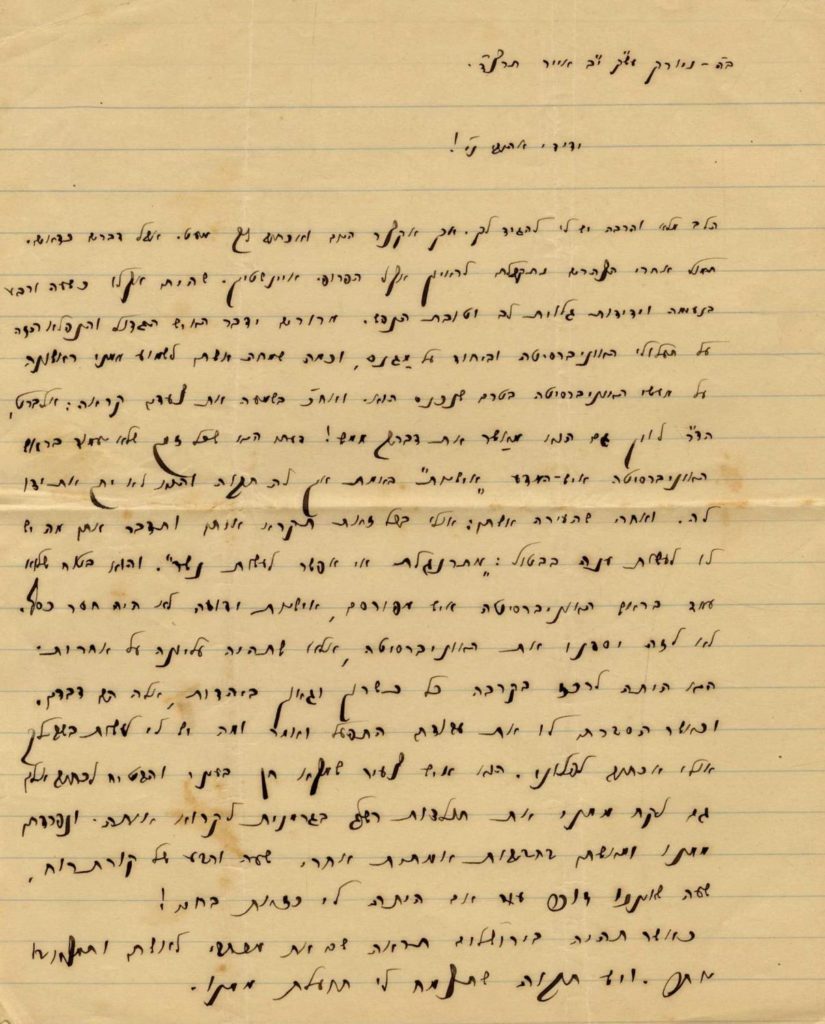
Large archive containing approximately 100 letters to Rabbi Shaul Chona HaKohen Kook, Rabbi Avraham Yitzchak HaKohen Kook’s brother, sent to him on various topics. Inter alia, the situation of the Jews abroad, maintenance of institutions in the Land of Israel, innovations in the world of research in general and the world of Torah literature in particular, and personal subjects. Most of the letters are handwritten, a few were typewritten.
Among the rabbis who wrote to him were Rabbi Meir Berlin and Rabbi Ben-Tziyon Chai Uziel. Scholars include David Yellin, Gershom Scholem, Binyamin Menashe Levin, Yisrael Davidson, Simchah Asaf, Azriel Carlebach, David Tzemach, Yaakov Nachum Epstein, Yehoshua Brand [in which he writes of his plan to establish an Institute of Talmudic Realia], Moshe Zeidel, Chaim Sherman, Shalom Spiegel, Avraham Schwadron.
It is interesting to read the letter written by Binyamin Menashe Levin in which he describes discussions he had with Professor Albert Einstein about the role and situation of the Hebrew University at its inception. Einstein said about the university: “A rooster cannot be made into an eagle.”
Various scholars thanked him in their letters for the many comments he made on their books and articles and their plans to publish new books. There are also condolence letters which were sent upon the passing of his brother, Rabbi Avraham Yitzchak HaKohen Kook.
Rabbi Shaul Chona HaKohen Kook was a public activist and scholar in the humanities; he was a Zionist activist connected to the Mizrachi movement. He published hundreds of articles in various journals and corresponded with leading scholars of his time regarding their articles.
The archive was examined only superficially, and is in overall fine condition.
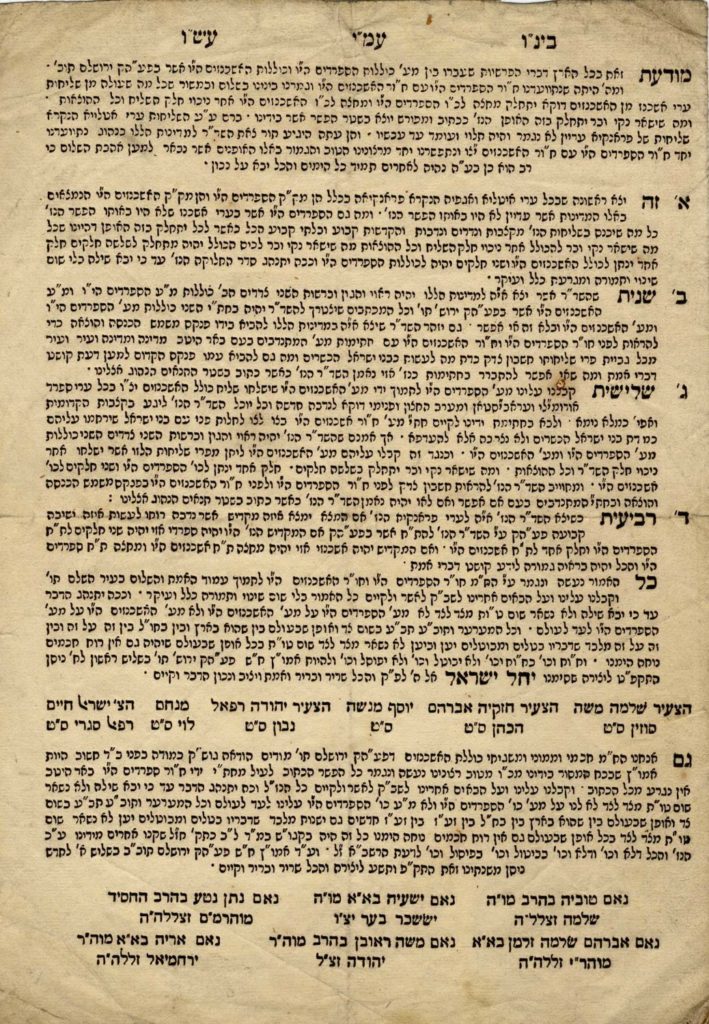
Nationwide notification. Agreement between the kollels of the Ashkenazim and Sephardim of Jerusalem regarding the division of funds raised in the cities of Italy by an emissary. With the handwritten signatures of Ashkenazic and Sephardic rabbis of Jerusalem.
Long, detailed agreement that was made before Rabbi Avraham Shlomo Zalman Tzoref was sent as an emissary to Italy. Six Sephardic rabbis and six Ashkenazic rabbis signed the agreement, among them: Rabbi Shlomo Suzin, Rabbi Chizkiyah Avraham HaKohen, Rabbi Yehudah Navon, Rabbi Yisrael Chaim Raphael Sagri, Rabbi Yeshayah Bardaki, Rabbi Natan Nota of Shklow and more. The poster was printed in Livorno for the Jews of Italy. About the agreement, see Y. Rivkind, Yerushalayim , in memory of A.M. Lunz (1928), 153-156, A. Ya’ari, Shluchei Eretz Yisrael , 774-775.
Rare, not in the National Library, listed in the Bibliography of the Hebrew Book according to a copy from the Beit HaMidrash L’Rabbanim, New York.
[1] printed leaf, 29×20 cm. Fine condition. Aging stains.
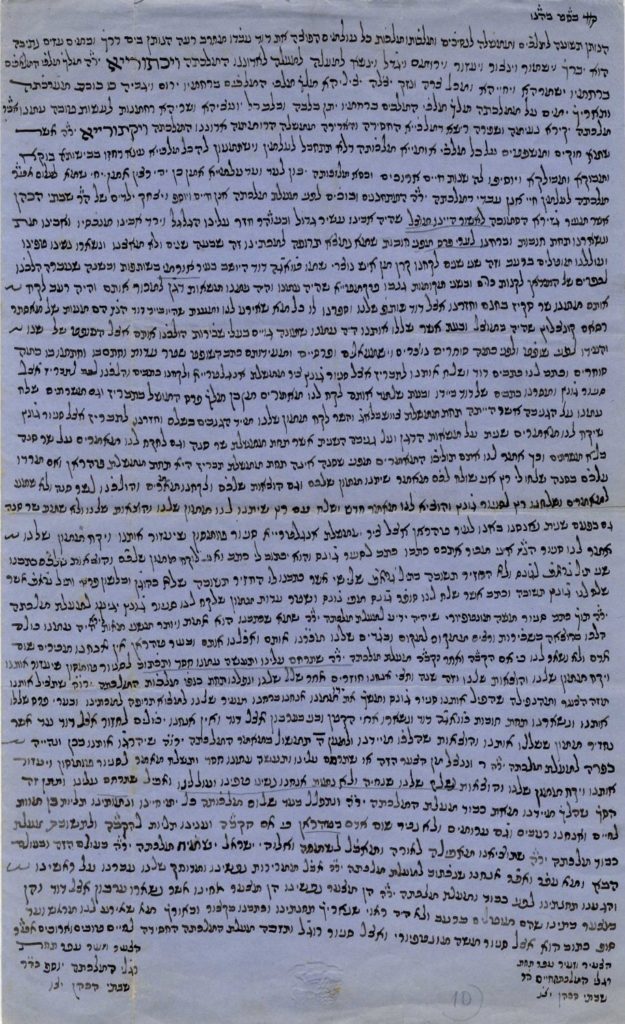
Letter from two Jewish merchant brothers from Persia to the Queen of Britain, with a request to rescue them from their distress. Teheran, 19th century.
Rare authentic appeal to the queen of the British Empire, to save the life of a Jewish family exiled to Teheran and whose lives are endangered due to an economic entanglement. In this rare and special letter, two Jewish merchant brothers tell their painful personal story: Their father had been wealthy, but the wheel turned and he lost his property. He passed away leaving many debts behind him, so that his sons were forced to flee from the city of Goram Jazeera, near Assyria Hynu Muzal (Mosul in southern Iraq) to the cities of Persia, where they borrowed money to purchase merchandise. The merchandise was stolen from them – not just once or twice – they describe in detail the series of events and attempts to appeal to the consul etc., but to no avail. Their situation is too difficult to bear and their children and wives are suffering starvation. They are trying to be extricated from the distress by direct appeal to Queen Victoria ‘to have mercy on us, show kindness to us, and write to Senior Thompson to assist us and take our money …”
This letter’s story is essentially the story of Jews in exile in various places and periods who groaned under the yoke of the non-Jews and were subject to trampling and plunder.
[1] page, blue paper. 35×21 cm. Oriental handwriting. Embossed seal of a lion impressed on the bottom of the leaf.
Very fine condition, fold mark.
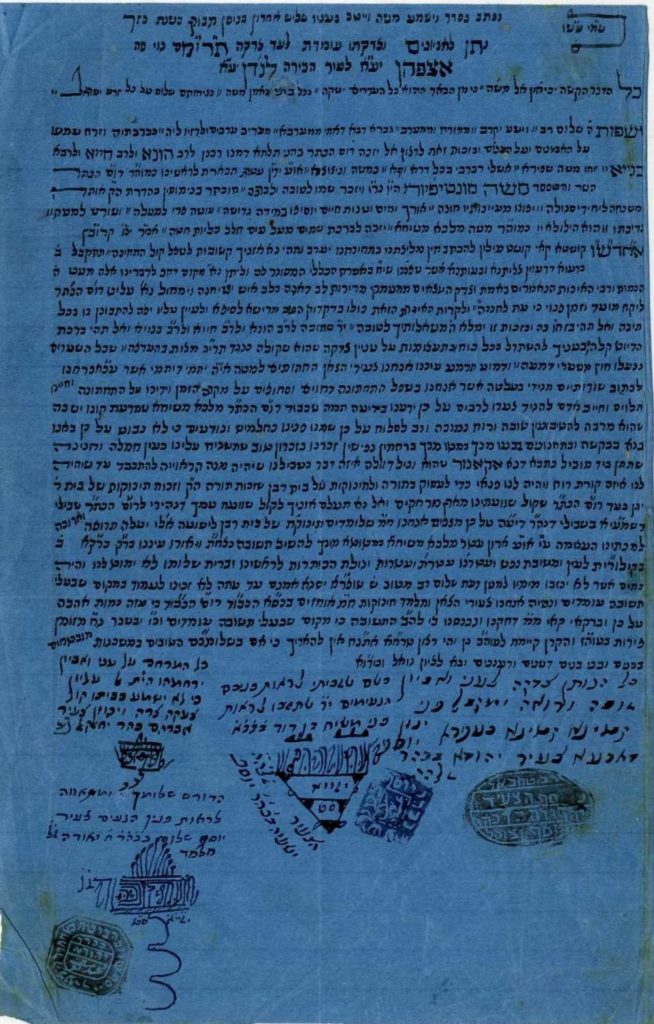
Letter with a cry for help ‘Our eyes tear over, we the young sheep who have signed below … we are at a low … anguished and adrift …’ Persia, 1880. Very rare.
Calligraphic signatures of the following rabbis of Isfahan appear on the letters:
Rabbi Yehudah son of Yosef
Rabbi Yeshayah son of Yosef
Rabbi Avraham son of Yechezkel
Rabbi Yosef Shalom son of Yehudah Melamed
21×13 cm. Dark blue paper.
Condition Fine-very fine. Aging stains, folds at the edges of the leaf.
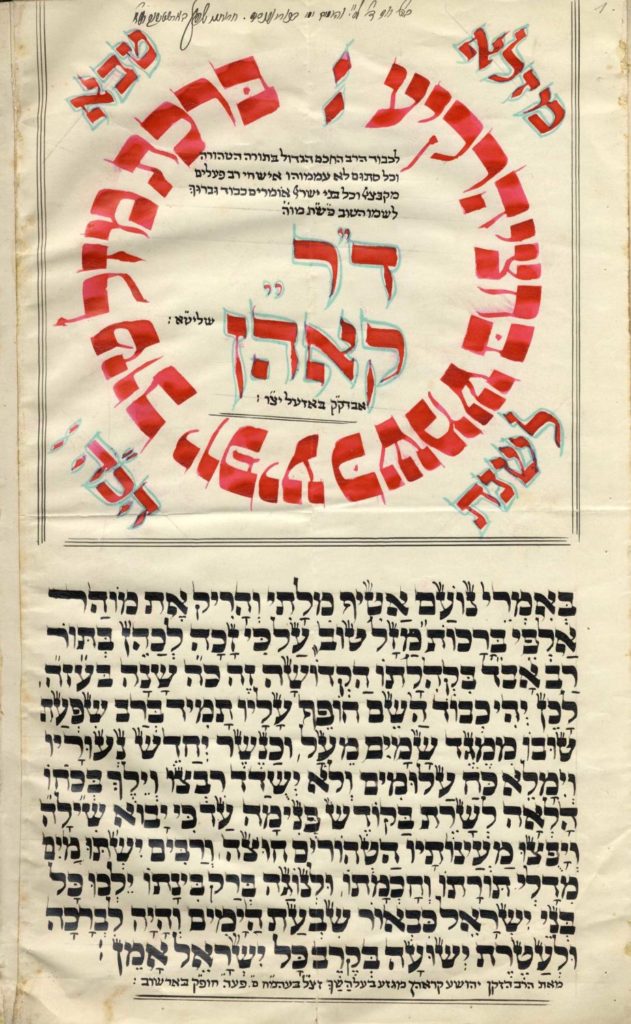
Hundreds of letters and telegrams of greeting by rabbis, public figures and institutions wishing him success as rabbi, from across Western Europe and the Land of Israel.
Approximately 300 items, most of them in German, and a few in Hebrew.
Rabbi Dr. Asher Michael Cohen (1862-1926) was one of the leaders of the Chareidi community of Switzerland, a leading disciple of Rabbi Azriel Hildesheimer. As a youth he was already ordained as a rabbi and was appointed the rabbi of Basel (northern Switzerland), a position he held for approximately forty years, until his passing.
Among the senders of the greetings:
Institutions of the Basel community, including a list of students.
Mr. Solly Guggenheim, a very close friend of the rabbi’s, and one of the important figures of the community. Rabbi Dov Hillel Konigsberger Av Beit Din of Pleshine (entirely in Hebrew), Rabbi David Tzvi Hoffman, a rabbi and lecturer in Berlin; Rabbi Meir Hildesheimer; Rabbi Moshe Michael Cohen, Av Beit Din of Fulda; Rabbi Sinai Seifer Av Beit Din of Karslruhe; Rabbi Shmuel Chaim Schiller, Av Beit Din of Colmar.
Leaders of the Zurich community and its institutions, leaders of the Freiburg community (south Germany), the heads of the Pressburg yeshivah; the “Office of the Zionist Center” (with a postage stamp with Herzl’s portrait); Berlin; Paris and more.
Rabbi Cohen corresponded on halachic and practical matters with contemporary rabbis, such as Rabbi Yitzchak Elchanan of Kaunas (Kovna) and Rabbi Avraham Yitzchak HaKohen Kook. In 1897, he suggested to Herzl that the first Zionist Congress be held in his city, after the objection of rabbis of various circles (both Orthodox and Reform) to the congress being held in Munich, as was initially planned. Rabbi Cohen even took part in the Congress and was its first speaker. On the other hand, he was one of the initiators of the ‘Agudat Yisrael’ movement and one of the first rabbis in Germany who called the Chareidi community to unite within its framework. He took part in the inaugural congress of ‘Agudat Yisrael’ in Katowice and was its first speaker.
Description
Green binding with gilt imprint. Various sizes and conditions. Fine-very fine overall condition.
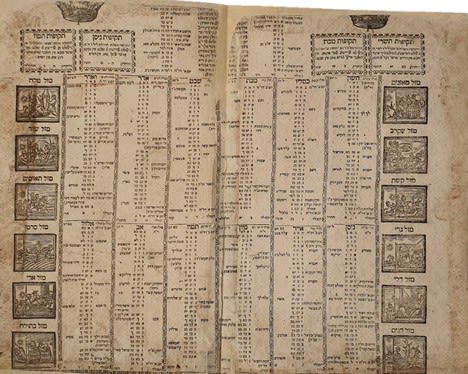
Calendar leaf with the names of the weekly Torah portions, the times of the new moon, the recognized festivals and dozens of unknown ones [“Poilish Teg,” “All Photographers,” “Beginning of Dogs’ Days,” “New Woman,” “Last Woman and Eyes Lighten Market” and many more]. With commentary and additions in Hebrew and Deutsch-Yiddish. Engraved illustrations of the twelve signs of the Zodiac on both sides of the leaf. Printed by Rabbi Wolf Levi’s successors, [Frankfurt, 18th century].
This calendar does not appear in the National Library and is not listed by the Bibliography of the Hebrew Book.
[1] leaf of thick, deluxe paper. 33×43 cm. Moderate-fine condition. Professional restoration. Several tears and tiny holes. Cropped upper margins. Erasures.
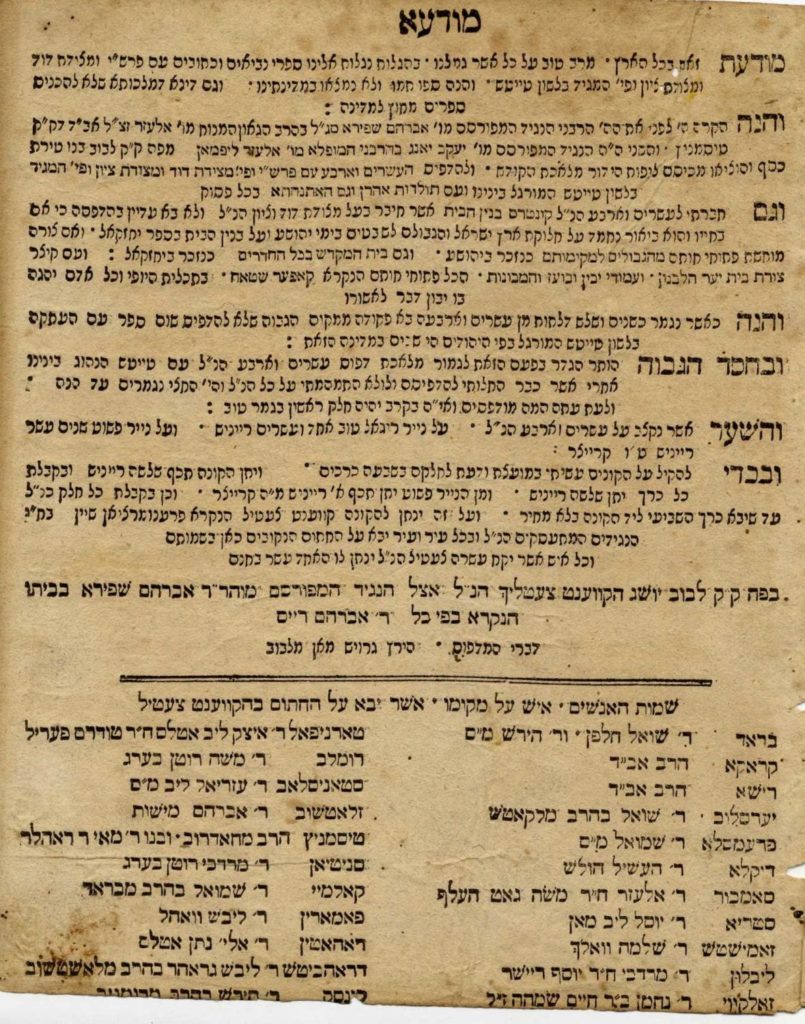
Nationwide notice. Announcement from printer Naftali Hertz Grossman of Lemberg regarding the printing of the Nach with Yiddish translation, with details about the edition. [Lemberg, 1808]. Nach HaMaggid was printed by Grossman in 1808.
Announcement from the famed printer in Lemberg regarding the printing of Nach HaMaggid , with details regarding those facilitating the printing, special supplements and more. The printer also discusses the government’s prohibition on printing books with Yiddish. He writes that the printing will be on two types of paper, regular and high-quality, and mentions price and payment plans.
[1] leaf paper. 21×18 cm. Cropped minimally at the bottom. Fine condition.
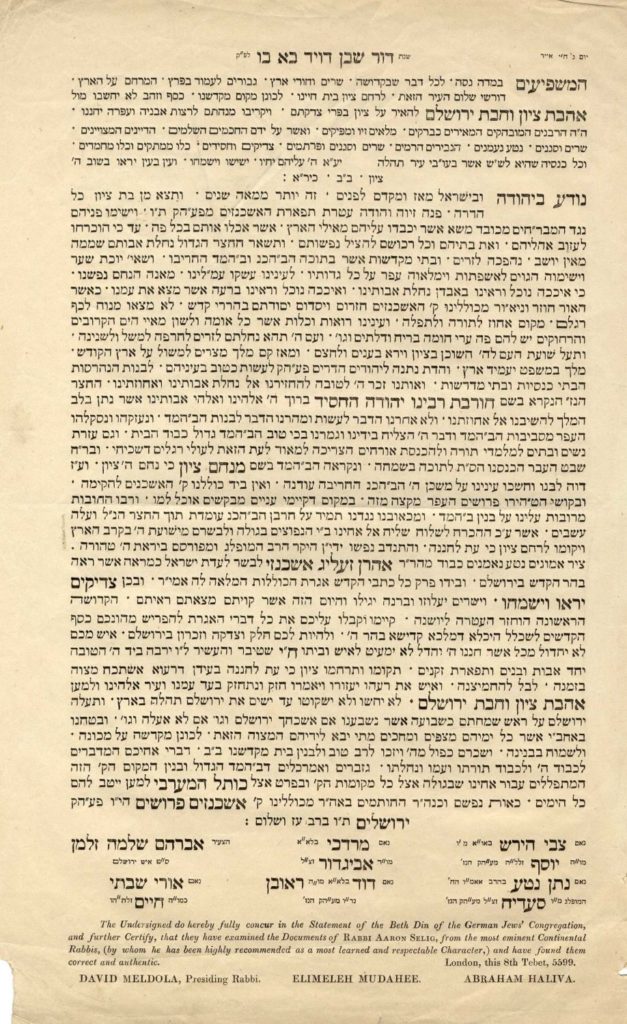
Letter from the leaders of the Ashkenazic kollellim for an emissary sent to raise funds for the construction of the Churvah synagogue. Printed on paper. [London?] 1839.
Lengthy letter describing conditions in the yishuv in Jerusalem and the desire to construct the Churvah synagogue. The letter mentions that the Menachem Tziyon Synagogue was established, but that “Churvat Rabbi Yehudah HeChassid” is still a ruin. The Menachem Tziyon synagogue was inaugurated in 1837. It was the first Ashkenazi synagogue established after the revitalization of the yishuv in the city. After it was finished, plans were started to build the Churvah, and it seems that this letter was written at the time. The margins of the letter bear the added signatures of London rabbis, from 1839.
The letter opens with the sentences: “To those who greatly influence everything related to holiness.” It is signed by six of the leaders of the Ashkenazi kollels in Jerusalem. As mentioned, the margins have additional referrals from the rabbis of London from 1839, in English. An English translation of the letter is printed on the opposite page.
For more information regarding this fundraising mission, refer to: HaChurvah: Shesh Meot Shanim shel Hityashvut Yehudit BiYerushalayim , Jerusalem, 2010, p. 80. In addition, refer to Yaari, Shluchei Eretz Yisrael , p. 783-785.
[2] pages. 34×21 cm. Fine condition. Light tears without loss and tear along the fold.
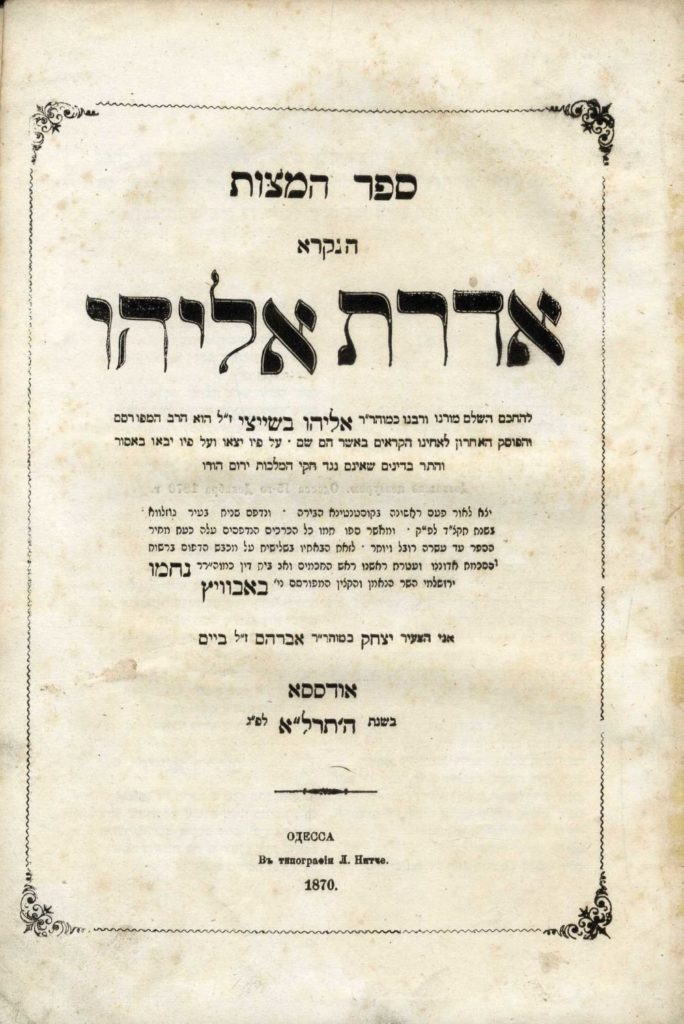
Sefer HaMitzvot according to the Karaites , by the sage Eliyahu Bašyazi, “the last adjudicator of our Karaite brethren …” Odessa, 1871. Tables and sketches.
With many tables of the courses of the sun, the moon and the Zodiac, to calculate the sanctification of the month. In addition, two folded plates with tables related to the sanctification of the month. These leaves are not found in all copies of the book.
Complete copy, including [8] leaves at the beginning, more than is listed in the Bibliography of the Hebrew Book. On the first pages, a long list of members of the Karaite community in Russian cities of who had paid in advance.
Specifications: [8], 128 leaves. 27 cm. Very fine condition. Minimal aging stains.